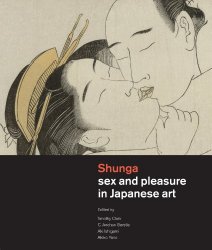Shunga – Erotic Pictures from the Floating World 春画
by Johannes Schonherr, October 2015
Ukiyo-e (Pictures from the Floating World) are woodblock images depicting life in all its aspects during the Edo Period (1603-1868).
Travel and landscapes, studies of the daily work and pleasures of the Edo (present-day Tokyo) population as well as the farmers, fishermen, merchants, soldiers, samurai, and daimyo in the provinces were realistically and often humorously captured by skilled artists such as Katsushika Hokusai (1760-1849), Utamaro Kitagawa (1753-1806), Harunobu Suzuki (1725-1770) and Eishi Chobunsai (1756-1829).
Realistic paintings of life in Japan were actually made long before the Edo era, but it was in the Edo Period that the technique of wood printing came to full fore.
Woodcarvers and printers experimented with new printing inks, and materials like gold, silver, and exclusive pigments were also put to use to create the finest private editions of the images.
But printing also meant that the images could be replicated in large numbers, they could be mass-produced.
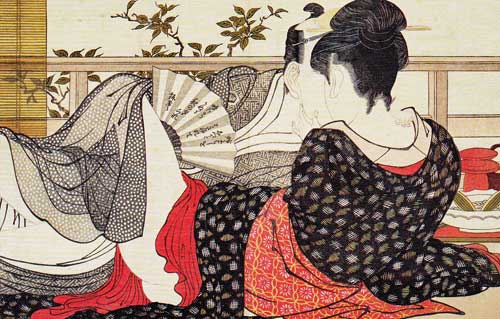
While a painting would be an original that could be sold only once at a time, identical wood prints could be made available for a relatively low price to a wide range of the population.
Among the most famous ukiyo-e today is Katsushika Hokusai’s series 36 Views of Mt. Fuji, including The Great Wave off Kanagawa, known to virtually everyone with even the slightest interest in Japan.
Shunga
Lesser known is that the ukiyo-e concept of covering almost all aspects of contemporary life included both the real and the artistically imagined sex life of Edo Japan. Those pictures are known under the name shunga (which translates to “Spring Pictures”).
Shunga were produced by the same artists who also worked in other fields of ukiyo-e. Some of the most famous shunga were drawn for example by Hokusai when he took a break from studying Mount Fuji from all its angles.
On the other hand, no artists are known today who produced only shunga. Shunga were not the work of specialized pornographers. Sex was considered a natural part of life in Edo Japan and the production of erotic images reflected this point of view.
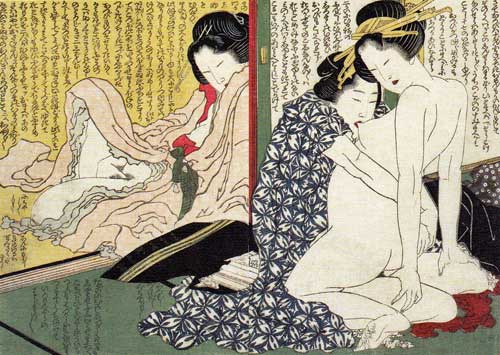
Sex in Edo Times
Edo Japan was not a paradise of sexual liberty. The feudal class hierarchies were very strict and the penalties for breaking the rules were draconian. A farm boy falling in love with the daughter of a samurai? Unthinkable. If such a liaison would have been discovered, the farm boy would have to count himself lucky if the samurai wouldn’t do anything worse to him than cutting him to pieces with his katana.
But within the given social structure, a lot of things were relatively easy-going. Prostitution districts existed in every town, Tokyo’s Yoshiwara being the most famous but not the only one by far. In fact, prostitution took place at many bath houses / hot springs as well as at the tea houses (which were in fact often run as part of the bath houses). For the hard-working day laborer, paid sex was certainly within reach.
Men with the means to afford it often had concubines aside from their wives, and young folks fell in love and ran away with the maid they met in the hostel where they stayed – Japanese literature is awash with such stories.
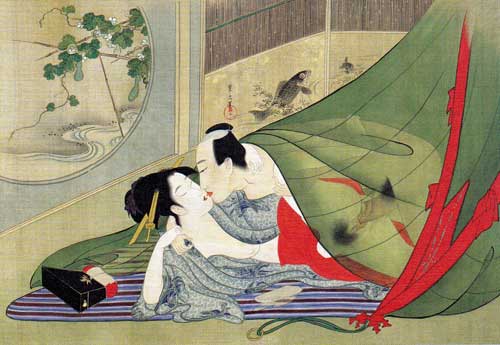
Shunga Styles and Content
The wood print artists were fascinated by the romantic and sexual aspects of life just as the writers were. Both bent and exaggerated the topics they depicted in their own way.
Well aware of the fact that men and women could see each other unclothed at public baths and hot springs without restrictions at any given time, they had to add graphic erotic excitement.
The wood print artists went for extremely oversized genitals. “Had I depicted it [the genitals] in its actual size, there would be nothing of interest. Don’t we say art is fantasy?” quotes the book Kokon chomonju (Famous Sayings Old and New, 1254) a monk already painting shunga in the Kamakura Period (1185-1333).
That nudity as such was nothing that would arouse much interest in Edo Japan also led the woodcarvers to dress the protagonists in their pictures in dramatically arranged kimonos during their sex acts. Elaborate dressing revealing nothing but the center of the action was their way of presentation.
But if you look closer, a lot of the emotions depicted are not only shown via the sex acts themselves and the way dresses get rearranged through them but also in the faces, the fingers, and the hair of the people in the images.
A lot of historical detail can be spotted as well, like the blackened teeth of fresh brides (a fashion of the times). The male members were of course left uncircumcised. Circumcision was an unknown concept in Japan at the time.
The people depicted ranged from noblemen to samurai to kabuki actors to just regular people such as merchants and farmers. Very common was the portrayal of prostitutes at their work with their customers. Virtually no stratum of society was excluded.
As diverse as the variety of people depicted, as various was the variety of the sex acts themselves. Heterosexual encounters in all imaginable forms formed the bulk of the pictures. Gay and lesbian encounters were however also present as well as rather fantastic trysts.
The protagonists all appear to be enjoying themselves and there is little or no depiction of coercion.
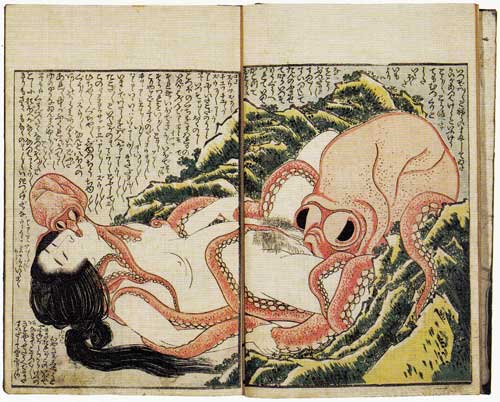
One of the most famous shunga ever carved is Hokusai’s The Dream of the Fisherman’s Wife. The Japanese title of the work is Ama to Tako (The Pearl Diver and the Octopus) (1814) and it shows a nude woman being fondled by both a large and a small octopus.
In fact, ama (female pearl divers) formed their own subculture at the time and they typically dived naked. Much later, in the 1960s, pink movies also put a focus on the always fascinating ama.
Shunga were both sold as rather expensive scrolls as well as in the form of books. The latter typically allowed for a greater variety of genres. Though long scrolls could certainly tell exciting stories, it was books that were able to reprint classic novels like, say, the Tale of Genji, but illustrate them with erotic images.
From time to time, the Tokugawa shogunate published books telling young women how to behave properly. Such books were quickly satirized in shunga, mocking the correct morals of the original works with lascivious content while staying very close to the format and style of the official publications.
According to historical accounts, shunga were popular across the whole spectrum of society. While the rich bought lavish private editions, the less monied rented the books from itinerant book lenders for a little cash. These book lenders, men carrying huge stacks of books on their back through urban neighborhoods, provided of course not only shunga but novels, medical books, and other readings to their customers as well.
Shunga Distribution
But shunga were a popular mainstay and an important part of itinerant book lenders’ business. They would go to a house, show the books available, lend out the ones desired and recollect them after an agreed period of time. At the time, that was most likely the most common way to enjoy shunga. Men and women were both eager customers.
The majority of the shunga available today is however of the more expensive private collector variety. Those were prized items worth keeping while hardly anybody cared about preserving the day-by-day book lender offerings. Fortunately, some have survived nonetheless.
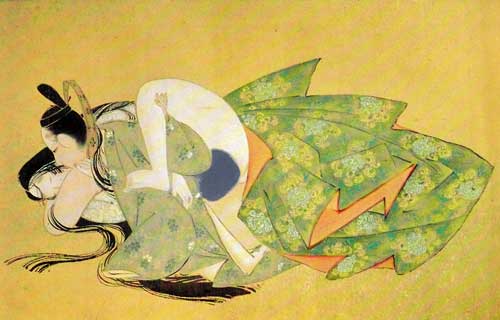
Censorship
The governing Edo shogunate was ambivalent towards shunga. The shogunate knew that the internalization of a set of strict rules by the population was essential for successful government. But the shogunate also knew the mindset of the people it ruled and thus allowed the Yoshiwara and other prostitution outlets to freely operate. That people needed a release every once in a while was understood by the shogunate authorities.
Within the Edo Period, there were times when shunga were tolerated and times when they were officially prohibited. In the former case, the shunga were published with full credits to artists, wood carvers, and printers. In the latter, shunga were either sold as exclusive private prints or rented out by book lenders flouting the law.
Those Edo Period shunga prohibitions were usually short-lived and after the widely announced anti-shunga campaigns open sales tended to be back rather quickly.
When Japan opened towards the West during the Meiji Restoration (in the late 1860s) Westerners were often given shunga as presents. While the Japanese considered shunga treasured gifts, many Westerners rejected them. They were puritans of the Victorian age, after all.
Along with public nudity and unisex baths, the Meiji government (1898-1912) prohibited shunga. Open expressions of sexuality became seen as backward in a time when the Japanese government wanted to keep up with advanced Western countries.
Shunga did find fans in the West, however. Artists such as Auguste Rodin, Aubrey Beardsley, and Pablo Picasso are known to have been inspired by Japanese erotic prints.
From the 1970’s on, shunga could be published again in Japanese books but the genitals had to be covered by fog spots – just as in pink movies. Japanese sex museums (hihokan) displayed some original shunga for adults only. Even there, fog spots were in place.
Only very recently can shunga be shown openly and uncensored in Japan again. At the time of this writing, for example, a large shunga exhibition can be seen at the Eisei Bunko Museum in Tokyo.
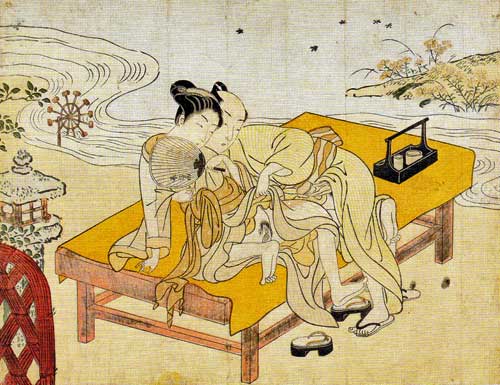
Shunga Exhibition at Eisei Bunko Museum
Eisei Bunko Museum (eiseibunko.com)
1-1-1 Meijirodai, Bunkyo-ku, Tokyo
Tel: 03 3941 0850
Open daily until December 23rd, 2015
Opening times: 9.30am – 8pm
Admission: 1500 yen per person, nobody allowed in younger than 18 years of age.
Access: Train: 15 minutes walk from Edogawabashi Station on the Yurakucho subway line.
Bus: From JR Mejiro Station, take the Toei Bus for the West Exit of Shinjuku Station and get off at the Mejirodai-sanchome stop.
Shunga books on Amazon.com
Shunga: Aesthetics of Japanese Erotic Art by Ukiyo-e Masters
This is a huge 592-page tome. Bilingual in English and Japanese. This book is also sold at the gift shop of the Eisei Bunko Museum during the time of the Shunga Exhibition (7,380 yen).
Shunga: Japanese Erotic Art (Bilingual in Japanese and English)
Shunga: Erotic Art in Japan (Author Rosina Buckland is the curator of the Japanese collections at the National Museum of Scotland)
Shunga: Sex and Pleasure in Japanese Art (Catalogue of the big shunga exhibition at the British Museum in London 2013)
